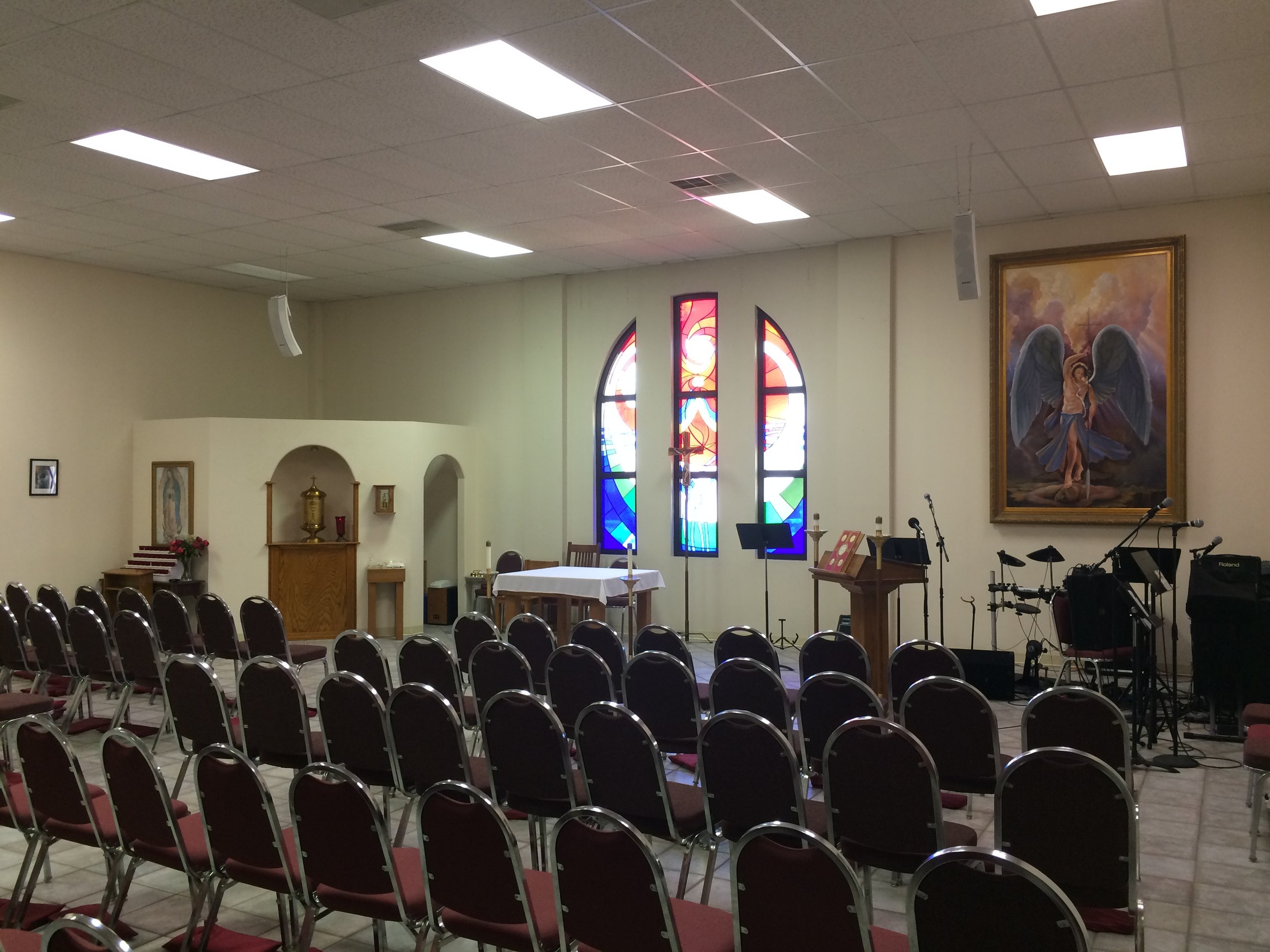Parish Renovation Considerations
by Michael Raia
Often times parish improvements are postponed until they can be pursued as part of a large project. At times this makes sense, and in other situations it can make a lot of sense to evaluate the handful of changes that could be made to keep facilities functioning well and looking great. Whether the project is a partial church renovation (sanctuary, restrooms, confessionals, narthex, etc.) or projects in another area (parish hall, meeting rooms, reception lobby, kitchen, youth room, library, etc.) these can often be addressed in a number of ways. Here are a few suggestions for thinking about areas of your parish campus that might be closer to a facelift than you think.
Chapel at West Texas A&M Catholic Student Center – BEFORE
Chapel at West Texas A&M Catholic Student Center – AFTER (Phase 1, prior to Sacred Art & Furnishings)
Consider the Scope.
Are there functional or aesthetic issues with major and expensive elements such as HVAC equipment and plumbing fixtures, or are there easier problems to address such as repainting walls, replacing old ceiling tiles, or replacing old furniture? Some areas might be a bit harder to determine, such as flooring and lighting. For instance, an old ceramic tile floor would need to be removed prior to any sort of replacement, which is messy and can be costly. For floors that are carpet, sheet vinyl, or vinyl composition tile, however, it can be fairly simple and cost-effective to do something new. Similarly, lighting can also go either way. Sometimes fixtures just need to be upgraded in place and it can be simple and inexpensive to do so, such as the ubiquitous 2x4 fluorescent troffer lights in almost every classroom. There are hundreds of attractive, affordable, and efficient replacement options. Other times, fixtures may not be functioning well because they are the wrong type or are in the wrong location. Of course these fixes could be more difficult to execute.
Don't Overlook Regulations.
Keep in mind many dioceses have a budget trigger for projects beyond a certain dollar amount needing approval at various levels, and in many places any liturgical changes need to be reviewed by the Diocese as well. In addition to Diocesan requirements, the various jurisdictions – city, county, state, will also have requirements that could be triggered. These would include building codes, state accessibility codes (ADA), county regulations for food service or fire, and city ordinances – all of these are structured differently for parishes in different locations. For instance, certain upgrades to a non-ADA-compliant restroom, or significant changes throughout other parts of a building with non-compliant restrooms may trigger full compliance in the restrooms and throughout the building. It is a very good idea to consult with the Diocese and a design professional such as an architect to discuss these considerations. Additionally, changes to structural systems (including load-bearing walls), mechanical HVAC systems, electrical, and plumbing should always be performed by licensed and insured professionals with the requisite permits.
Evaluate Delivery Method Options.
In the design and construction industry, the term delivery method refers to how a project will be completed. For a renovation project, there would primarily be three options:
- Construction Manager: Larger projects will typically be best completed by a trained professional who will manage the construction and contract any sub trades which might be needed. This approach offers a single point of contact and depending on the size of the project and the type of work the construction manager does, also offers the protection of proper bonding, insurance, and other industry standard protocols that ensure the work is done safely, up to code, and in a way that is fiscally transparent. Within this option, the benefits of larger and smaller contractors should also be weighed.
- Self-Contracted: If the project will involve only a few major trades, especially if the parish has a staff member or volunteer with construction experience and the time to invest, this approach might be ideal. For instance, a project that will only involve
- Self-Performed: If there is a proficient facilities staff or group of experienced volunteers such as former or full-time contractors or groups like KCs who regularly complete construction projects, it may make sense for the parish to invite these individuals to complete all or some of the work without engaging a third party. There are obvious benefits in terms of saving money, but the work quality is something that could be compromised, and there are also safety and liability concerns. Volunteer labor does not always yield satisfactory results.
- Hybrid: A combination of the first three options could be ideal in certain circumstances. There may be major elements in a job that need to be coordinated through a skilled professional construction manager, such as a HVAC, flooring, and electrical. The parish may also desire to independently contract other professionals such as AV installers and security / communications specialists. Finally, if there are areas of work requiring little skill, such as flooring removal or painting, the parish may choose to utilize volunteer labor.
Taking all of these things into consideration, it can seem that renovation projects can quickly become complex. On the other hand, it is not always the case that they need to be postponed until a lot of resources can be put into them. Hopefully these guidelines are helpful in considering which areas of your parish campus might benefit from a little attention and care.
If you have a renovation project idea you'd like to ask some preliminary questions about or discuss in greater detail, please contact us.


